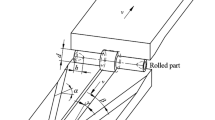Abstract
Cross wedge rolling (CWR) is an innovative metal forming technology with several well-documented benefits over other traditional manufacturing processes. Over the past several years, CWR technology has obtained overwhelming popularity within the United States, especially in the automotive industry. Based on the authors’ academic and industrial experience, recent development techniques for the CWR process are presented. Initially, the experimental and numerical research techniques for analyzing fundamental CWR failure mechanisms are presented with particular emphasis on the finite element method. This is followed by discussion on industrial implementation of cross wedge rolling system, including the required tooling manufacturing process and major supporting systems. Finally several industrial examples are presented to demonstrate feasibility and efficiency of the CWR process with the goal of removing hesitation of US manufacturers to adopt novel CWR technology.
Similar content being viewed by others
References
Fu XP, Dean TA (1993) Past developments, current applications and trends in the cross wedge rolling process. Int J Mach Tools Manuf 33:367–400
Lebek A (1879) Rollmachine zue Herstellung von Rotationssymmetrischen Korpern. Deutcjes Patent, 10089V
Balin AF (1959) Forgings of cross wedge rolling. Mashgiz, Moscow
Saito Y, Higashino T (1977) Strain analysis in plane-strain rotary compression of cylindrical billet. J JSPT 18(193):120–127
Hayama M (1979) Optimum working conditions in the cross rolling of stepped shafts. J Mech Work Technol 17(3):31–46
Cho NS, Na KH (1990) Analysis of the rotational compression of a cylindrical billet in the transverse rolling process. J Mater Process Technol 22:203–216
Pater Z (1997) Theoretical method for estimation of mean pressure on contact area between rolling tools and workpiece in cross wedge rolling prcess. Int J Mech Sci 39(2):233–243
Jain SC, Kobayashi S (1970) Deformation and fracture of an aluminium alloy in plane strain side pressing. Proc. 11th MTDR conf. Birmingham, UK, pp 1137–1154
Hayama M (1974) Estimation of load and contact width in rotational compression of rod. J JSTP 15(157):141–146
Na KH, Cho NS (1989) Analysis of plain-strain rotational compression using the upper bound method. J Mech Work Technol 17(19):211–222
Hu ZH, Xu XH, Sha DY (1985) Skew rolling and cross wedge rolling- principles, processes, and machines. Metall. Ind. Press, Beijing, China
Luan GF, Zeng GL, Guo CW (1984) The study on the technological parameters, load and power parameters on 3-roll cross wedge rolling. Proc 3rd Int Conf Rotary Metalworking processes, Kyoto, Japan, pp 333–343
Danno A, Tanaka T (1984) Characteristics of billet deformation in three-roll wedge rolling of axisymmetric stepped shafts. Proc. 3rd Int. Conf. Rotary Metalworking processes, Kyoto, Japan, pp 321–332
Li Q, Lovell MR (2002) Predicting critical friction in a two-roll cross wedge rolling process. J Tribol 125:200–203
Li Q, Lovell MR (2005) On the critical interfacial friction of a two-roll CWR process. J Mater Process Technol 160:245–256
Li Q, Lovell MR (2002) William Slaughter and Kaveh Tagavi, Investigation of the morphology of internal defects in cross wedge rolling. J Mater Process Technol 125–126:248–257
Li Q, Lovell MR (2004) Establishment of a failure criterion in cross wedge rolling. Int J Adv Manuf Technol 24:180–189
Johnson W, Mamalis AG (1977) A survey of some physical defects arising in metal working processes. Proc 17th International MTDR Conference, London, U.K., pp 607–621
Pater Z (1998) A study of cross wedge rolling process.” J Mater Process Technol 80:370–375
Dong Y, Lovell M, Tagavi K (1998) Analysis of interfacial slip in cross wedge rolling: an experimentally verified finite element model”. J Mater Process Technol 80–81:273–281
Thompson G, Hawkyard JB (1979) Crack formation in transverse rolling- a review. Proc 1st International conference On Rotary Metalworking Processes, London, U.K., pp 171–184
Smirnov VS (1947) The deformation process in cross rolling. Stal 7(6):511
Danno A, Tanaka T (1984) Hot forming of stepped steel shafts by wedge rolling with three rolls. J Mater Process Technol 9:21–35
Teterin PK, Liuzin JF (1960) The mechanism of metal rupture in cross rolling. Stal 10:930–933
Tselikov AI, Lugovsko VM, Tretiyakov EM (1961) The theory of cross cold rolling on three-roll machine. Vestn Mashinostroeniya 7:49–54
Li Q, Lovell MR, Deng Z (2001) Analysis of internal slip in a two-roll cross wedge rolling process. Trans NAMRI:9–16
Cowper GR, Symonds PS (1957) Strain-hardening and strain-rate effects in the impact loading of cantilever beams. Technical Report 28, Division of Applied Mathematics, Brown University
Tsao MCC, Campbell JD (1973) Plastic shear properties of metals and alloys at high strain rates. Technical Report AFML-TR-73-177. Air Force Materials laboratory, Wright Patterson AF Base, Ohio
Author information
Authors and Affiliations
Corresponding author
Rights and permissions
About this article
Cite this article
Li, Q., Lovell, M. Cross wedge rolling failure mechanisms and industrial application. Int J Adv Manuf Technol 37, 265–278 (2008). https://doi.org/10.1007/s00170-007-0979-y
Received:
Accepted:
Published:
Issue Date:
DOI: https://doi.org/10.1007/s00170-007-0979-y



